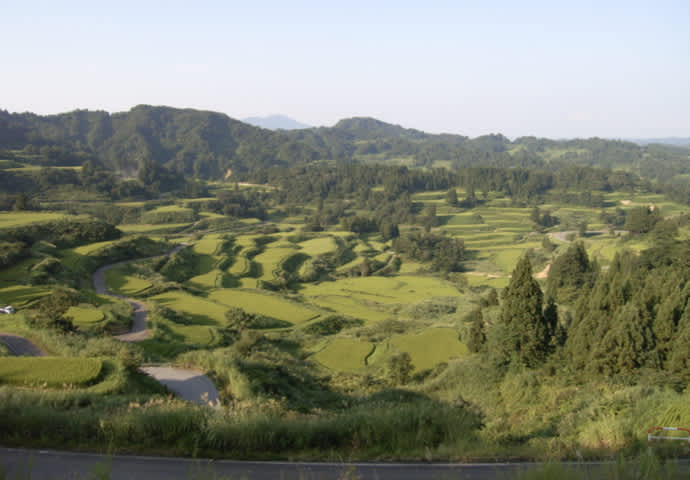
Experience daily life as a local on a journey of artistic cuisine, accommodations, and more
Experience daily life as a local on a journey of artistic cuisine, accommodations, and more
The Daichi Art Festival transforms an entire mountain village into a celebration of art

The Daichi Art Festival Echigo-Tsumari Art Triennale will be held this year between July 27 and September 17. The event happens every three years and was first held in the year 2000, so 2018 marks its seventh occurrence.
The concept behind the festival hasn’t changed since its inception—it’s all about immersing people in nature. Artists from all over the world offer their own interpretations on a common theme, with the various completed works spilling out of museums and arranged across the venue. The remote mountain village that the people of Echigo-Tsumari call home becomes filled with art.
Japan’s rural slopes are known as satoyama areas, and the word also implies a traditional way of life where people live in harmony with the land through traditional agricultural practices. Throughout the generations, these mountain villagers have used hard work and ingenuity to develop a rewarding lifestyle surrounded by nature. The wisdom of their ancestors is preserved in innovations like the stepped rice paddies nestled in mountain valleys that provide an essential staple crop and in the diversionary fields used to change the course of winding rivers.

The Rice Field is an installation by Ilya & Emilia Kabakov that is located in the Matsushiro area. It is made up of sculptures showing people doing agricultural work in the fields and accompanied by poems that describe a series of scenes essential to the planting, harvesting, and other farm work that goes on here. The piece reminds visitors of the role the fields play and the way the area looks year-round, not just while they’re here visiting.
More than 370 artworks like The Rice Field are scattered across a vast 760-km2 area, making the most of the land’s natural features. A trip to the Daichi Art Festival blurs the lines between art and daily life as visitors pass back and forth seamlessly between the two. It’s a unique experience that no art lover should miss.
Because the Daichi Art Festival includes art installations across such a large area, it’s nearly impossible to see everything in one day. Echigo-Tsumari is actually subdivided into six smaller areas, each with their own central art facility. The best way to see all of the art is to drive around to each of these structures or participate in a packaged tour. You can also buy an Art Lover’s Passport that gives you access to every work on display at the festival.
Unique installations make use of local resources, making them unique to Echigo-Tsumari

The Daichi Art Festival takes place in Echigo-Tsumari, a rural area with multiple challenges. In addition to being one of Japan’s few deep-snow districts, it also suffers from school closures and abandoned homes as a result of Japan’s aging population and low birthrate. During the festival, however these disused structures are repurposed as the inspiration for art.
One example is The Last Class by Christian Boltanski and Jean Kalman, installed in the Matsunoyama area. It breathes fresh life into an abandoned elementary school, adding rich expressive power that transforms the space into a celebration of the community and its love for the school.
Many other artists also use empty schools, homes, and other parts of the community to create art. Some of these projects become permanent installations, while others incorporate public works—these can be enjoyed outside of the fifty-one days of the festival itself.


A fascinating aspect of this trip is the fact that every key component—particularly the food and accommodations—is a celebration of art as well, continuing with the theme of bringing people and nature together.
The House of Light by James Turrell (located in the Kawanishi area) is the artist’s only installation that actually allows people to stay inside. Other artistic accommodations include the Katakuri Inn in the Tsunan area and the Sansho House in the Matsunoyama area—both of which repurpose disused schools and offer guests a chance to enjoy delicious homestyle dishes from the region.
The Ubusuna House is an old thatch-roofed farmhouse built eighty years ago in the Tokamachi area. It is a combination gallery and restaurant where you can admire traditional Japanese pottery while enjoying the local cuisine.
The Echigo Matsudai Satoyama Eatery is located in the central art facility of the Matsushiro area, the Matsudai Nobutai. It is a buffet-style restaurant with a glass-paned wall that lets you look out over the pastoral mountain scenery; mirrored tabletops reflect the scenes that local residents see outside of their homes along with the changing seasons. A trip to Echigo-Tsumari isn’t just about deciding what to eat or where to stay—it always comes with the added joy of choosing the kind of experience you want to have through the power of art.
The Daichi Art Festival attracts more repeat visitors each year. Once you experience it, you’re sure to be so charmed by Echigo-Tsumari that you’ll already be making plans to return.




















































